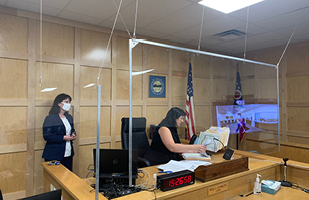'Life-Changing' Grants Help Courts in Present and Post-Pandemic

Justice Judith French, left, watches Mahoning County Judge Molly Johnson, right, exhibit her court’s new remote technology, which was funded by an Ohio Supreme Court grant.

Justice Judith French, left, watches Mahoning County Judge Molly Johnson, right, exhibit her court’s new remote technology, which was funded by an Ohio Supreme Court grant.
The coronavirus crisis has impacted all parts of Ohio’s judicial system, but a Supreme Court initiative to counter those effects has been transformative to courts in the state.
Mahoning County Courts 2 through 5 utilized more than $33,000 awarded through Ohio Supreme Court remote technology grants to purchase and implement videoconferencing hardware and software, enabling judges to continue with arraignments and hearings while following social distancing and other health guidelines during the pandemic. Prior to COVID-19, some dockets handling traffic citations and other low-level offenses regularly would have more than 100 people in a courtroom at a time.
“[The grants] really have been life changing. There are a million and one uses,” Mahoning County Judge Molly Johnson said.
Judge Johnson recently demonstrated the innovations in her courtroom at Mahoning County Court No. 5 in Canfield. On hand to observe was Ohio Supreme Court Justice Judith French.
“I hear a lot about the Supreme Court tech grants, and have celebrated the awards. But I rarely get to see the new technology in action,” Justice French said.
The upgrades include large videoconferencing screens with high-definition webcams and sound bars. The equipment allows the court to conduct video arraignments with inmates at the Mahoning County Jail and permits attorneys and litigants to be present in a separate room within the courthouse, or even from their homes or offices.
Born of necessity to follow public safety measures, the improvements will give the courts greater flexibility for the interim and for the future. The ability to connect lawyers, defendants, and litigants without anyone having to physically be in the same space increases options on how to manage cases. It also provides greater access to justice for those with health concerns or logistical issues preventing them from appearing in court.
“I think these innovations have real staying power. Courts are finding that the new technology makes their work easier, more efficient, and less expensive,” Justice French said. “It’s inspiring to see the modernization of our local courts. They’re finding new and better ways to serve the public.”
Legal Disclaimer:
EIN Presswire provides this news content "as is" without warranty of any kind. We do not accept any responsibility or liability for the accuracy, content, images, videos, licenses, completeness, legality, or reliability of the information contained in this article. If you have any complaints or copyright issues related to this article, kindly contact the author above.
